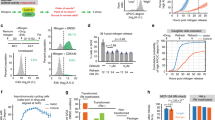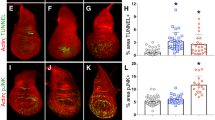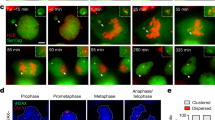Abstract
It has been proposed that the APC/CCdh1 functions as a tumor suppressor by maintaining genomic stability. However, the exact nature of genomic instability following loss of Cdh1 is unclear. Using biochemistry and live cell imaging of single cells we found that Cdh1 knockdown (kd) leads to strong nuclear stabilization of the substrates cyclin A and B and deregulated kinetics of DNA replication. Restoration of the Cdh1-dependent G2 DNA damage checkpoint did not result in G2 arrest but blocked cells in prometaphase, suggesting that these cells enter mitosis despite incomplete replication. This results in DNA double-strand breaks, anaphase bridges, cytokinesis defects and tetraploidization. Tetraploid cells are the source of supernumerary centrosomes following Cdh1-kd, leading to multipolar mitosis or centrosome clustering, in turn resulting in merotelic attachment and lagging chromosomes. Whereas some of these events cause apoptosis during mitosis, surviving cells may accumulate chromosomal aberrations.
This is a preview of subscription content, access via your institution
Access options
Subscribe to this journal
Receive 50 print issues and online access
$259.00 per year
only $5.18 per issue
Buy this article
- Purchase on SpringerLink
- Instant access to full article PDF
Prices may be subject to local taxes which are calculated during checkout







Similar content being viewed by others
References
Wäsch R, Engelbert D . Anaphase-promoting complex-dependent proteolysis of cell cycle regulators and genomic instability of cancer cells. Oncogene 2005; 24: 1–10.
Zhang J, Wan L, Dai X, Sun Y, Wei W . Functional characterization of Anaphase Promoting Complex/Cyclosome (APC/C) E3 ubiquitin ligases in tumorigenesis. Biochim Biophys Acta 2014; 1845: 277–293.
Peters JM . The anaphase promoting complex/cyclosome: a machine designed to destroy. Nat Rev Mol Cell Biol 2006; 7: 644–656.
Harper JW, Burton JL, Solomon MJ . The anaphase-promoting complex: it's not just for mitosis any more. Genes Dev 2002; 16: 2179–2206.
Pines J . Cubism and the cell cycle: the many faces of the APC/C. Nat Rev Mol Cell Biol 2011; 12: 427–438.
Sullivan M, Morgan DO . Finishing mitosis, one step at a time. Nat Rev Mol Cell Biol 2007; 8: 894–903.
Morgan D . Regulation of the APC and the exit from mitosis. Nat Cell Biol 1999; 1: E47–E53.
Wäsch R, Cross FR . APC-dependent proteolysis of the mitotic cyclin Clb2 is essential for mitotic exit. Nature 2002; 418: 556–562.
Wäsch R, Robbins JA, Cross FR . The emerging role of APC/CCdh1 in controlling differentiation, genomic stability and tumor suppression. Oncogene 2010; 29: 1–10.
Qiao X, Zhang L, Gamper AM, Fujita T, Wan Y . APC/C-Cdh1: from cell cycle to cellular differentiation and genomic integrity. Cell Cycle 2010; 9: 3904–3912.
Sudo T, Ota Y, Kotani S, Nakao M, Takami Y, Takeda S et al. Activation of Cdh1-dependent APC is required for G1 cell cycle arrest and DNA damage-induced G2 checkpoint in vertebrate cells. EMBO J 2001; 20: 6499–6508.
Bassermann F, Frescas D, Guardavaccaro D, Busino L, Peschiaroli A, Pagano M . The Cdc14B-Cdh1-Plk1 axis controls the G2 DNA-damage-response checkpoint. Cell 2008; 134: 256–267.
Floyd S, Pines J, Lindon C . APC/C Cdh1 targets aurora kinase to control reorganization of the mitotic spindle at anaphase. Curr Biol 2008; 18: 1649–1658.
Engelbert D, Schnerch D, Baumgarten A, Wäsch R . The ubiquitin ligase APC(Cdh1) is required to maintain genome integrity in primary human cells. Oncogene 2008; 27: 907–917.
Garcia-Higuera I, Manchado E, Dubus P, Canamero M, Mendez J, Moreno S et al. Genomic stability and tumour suppression by the APC/C cofactor Cdh1. Nat Cell Biol 2008; 10: 802–811.
Diffley JF . Regulation of early events in chromosome replication. Curr Biol 2004; 14: R778–R786.
Moore JD, Kirk JA, Hunt T . Unmasking the S-phase-promoting potential of cyclin B1. Science 2003; 300: 987–990.
Clijsters L, Ogink J, Wolthuis R . The spindle checkpoint, APC/C(Cdc20), and APC/C(Cdh1) play distinct roles in connecting mitosis to S phase. J Cell Biol 2013; 201: 1013–1026.
Nishitani H, Sugimoto N, Roukos V, Nakanishi Y, Saijo M, Obuse C et al. Two E3 ubiquitin ligases, SCF-Skp2 and DDB1-Cul4, target human Cdt1 for proteolysis. EMBO J 2006; 25: 1126–1136.
Johansson P, Jeffery J, Al-Ejeh F, Schulz RB, Callen DF, Kumar R et al. SCF-FBXO31 E3 ligase targets DNA replication factor Cdt1 for proteolysis in the G2 phase of cell cycle to prevent re-replication. J Biol Chem 2014; 289: 18514–18525.
Schnerch D, Follo M, Krohs J, Felthaus J, Engelhardt M, Wäsch R . Monitoring APC/C activity in the presence of chromosomal misalignment in unperturbed cell populations. Cell Cycle 2012; 11: 310–321.
Schnerch D, Follo M, Felthaus J, Engelhardt M, Wäsch R . The 3' untranslated region of the cyclin B mRNA is not sufficient to enhance the synthesis of cyclin B during a mitotic block in human cells. PLoS One 2013; 8: e74379.
Hendrickson M, Madine M, Dalton S, Gautier J . Phosphorylation of MCM4 by cdc2 protein kinase inhibits the activity of the minichromosome maintenance complex. Proc Natl Acad Sci USA 1996; 93: 12223–12228.
Fujita M, Yamada C, Tsurumi T, Hanaoka F, Matsuzawa K, Inagaki M . Cell cycle- and chromatin binding state-dependent phosphorylation of human MCM heterohexameric complexes. A role for cdc2 kinase. J Biol Chem 1998; 273: 17095–17101.
Ishimi Y, Komamura-Kohno Y, You Z, Omori A, Kitagawa M . Inhibition of Mcm4,6,7 helicase activity by phosphorylation with cyclin A/Cdk2. J Biol Chem 2000; 275: 16235–16241.
Masai H, Matsui E, You Z, Ishimi Y, Tamai K, Arai K . Human Cdc7-related kinase complex. In vitro phosphorylation of MCM by concerted actions of Cdks and Cdc7 and that of a criticial threonine residue of Cdc7 bY Cdks. J Biol Chem 2000; 275: 29042–29052.
Ishimi Y, Komamura-Kohno Y . Phosphorylation of Mcm4 at specific sites by cyclin-dependent kinase leads to loss of Mcm4,6,7 helicase activity. J Biol Chem 2001; 276: 34428–34433.
Komamura-Kohno Y, Karasawa-Shimizu K, Saitoh T, Sato M, Hanaoka F, Tanaka S et al. Site-specific phosphorylation of MCM4 during the cell cycle in mammalian cells. FEBS J 2006; 273: 1224–1239.
Wheeler LW, Lents NH, Baldassare JJ . Cyclin A-CDK activity during G1 phase impairs MCM chromatin loading and inhibits DNA synthesis in mammalian cells. Cell Cycle 2008; 7: 2179–2188.
Sigl R, Wandke C, Rauch V, Kirk J, Hunt T, Geley S . Loss of the mammalian APC/C activator FZR1 shortens G1 and lengthens S phase but has little effect on exit from mitosis. J Cell Sci 2009; 122: 4208–4217.
Eguren M, Porlan E, Manchado E, Garcia-Higuera I, Canamero M, Farinas I et al. The APC/C cofactor Cdh1 prevents replicative stress and p53-dependent cell death in neural progenitors. Nat Commun 2013; 4: 2880.
Ekholm-Reed S, Mendez J, Tedesco D, Zetterberg A, Stillman B, Reed SI . Deregulation of cyclin E in human cells interferes with prereplication complex assembly. J Cell Biol 2004; 165: 789–800.
Torres-Rosell J, De Piccoli G, Cordon-Preciado V, Farmer S, Jarmuz A, Machin F et al. Anaphase onset before complete DNA replication with intact checkpoint responses. Science 2007; 315: 1411–1415.
Neelsen KJ, Zanini IM, Herrador R, Lopes M . Oncogenes induce genotoxic stress by mitotic processing of unusual replication intermediates. J Cell Biol 2013; 200: 699–708.
Lengronne A, Schwob E . The yeast CDK inhibitor Sic1 prevents genomic instability by promoting replication origin licensing in late G1. Mol Cell 2002; 9: 1067–1078.
Ayuda-Duran P, Devesa F, Gomes F, Sequeira-Mendes J, Avila-Zarza C, Gomez M et al. The CDK regulators Cdh1 and Sic1 promote efficient usage of DNA replication origins to prevent chromosomal instability at a chromosome arm. Nucleic Acids Res 2014; 42: 7057–7068.
Bashir T, Dorrello NV, Amador V, Guardavaccaro D, Pagano M . Control of the SCF(Skp2-Cks1) ubiquitin ligase by the APC/C(Cdh1) ubiquitin ligase. Nature 2004; 428: 190–193.
Wei W, Ayad NG, Wan Y, Zhang GJ, Kirschner MW, Kaelin WG Jr . Degradation of the SCF component Skp2 in cell-cycle phase G1 by the anaphase-promoting complex. Nature 2004; 428: 194–198.
Yuan X, Srividhya J, De Luca T, Lee JH, Pomerening JR . Uncovering the role of APC-Cdh1 in generating the dynamics of S-phase onset. Mol Biol Cell 2014; 25: 441–456.
Ganem NJ, Godinho SA, Pellman D . A mechanism linking extra centrosomes to chromosomal instability. Nature 2009; 460: 278–282.
Drosopoulos K, Tang C, Chao WC, Linardopoulos S . APC/C is an essential regulator of centrosome clustering. Nat Commun 2014; 5: 3686.
Eguren M, Alvarez-Fernandez M, Garcia F, Lopez-Contreras AJ, Fujimitsu K, Yaguchi H et al. A synthetic lethal interaction between APC/C and topoisomerase poisons uncovered by proteomic screens. Cell Rep 2014; 6: 670–683.
Skaar JR, Pagano M . Cdh1: a master G0/G1 regulator. Nat Cell Biol 2008; 10: 755–757.
Alver RC, Chadha GS, Blow JJ . The contribution of dormant origins to genome stability: from cell biology to human genetics. DNA Repair (Amst) 2014; 19: 182–189.
Woodward AM, Gohler T, Luciani MG, Oehlmann M, Ge X, Gartner A et al. Excess Mcm2-7 license dormant origins of replication that can be used under conditions of replicative stress. J Cell Biol 2006; 173: 673–683.
Kawabata T, Luebben SW, Yamaguchi S, Ilves I, Matise I, Buske T et al. Stalled fork rescue via dormant replication origins in unchallenged S phase promotes proper chromosome segregation and tumor suppression. Mol Cell 2011; 41: 543–553.
Sorensen CS, Lukas C, Kramer ER, Peters JM, Bartek J, Lukas J . Nonperiodic activity of the human anaphase-promoting complex-Cdh1 ubiquitin ligase results in continuous DNA synthesis uncoupled from mitosis. Mol Cell Biol 2000; 20: 7613–7623.
Steigemann P, Wurzenberger C, Schmitz MH, Held M, Guizetti J, Maar S et al. Aurora B-mediated abscission checkpoint protects against tetraploidization. Cell 2009; 136: 473–484.
Held M, Schmitz MH, Fischer B, Walter T, Neumann B, Olma MH et al. CellCognition: time-resolved phenotype annotation in high-throughput live cell imaging. Nat Methods 2010; 7: 747–754.
Harrigan JA, Belotserkovskaya R, Coates J, Dimitrova DS, Polo SE, Bradshaw CR et al. Replication stress induces 53BP1-containing OPT domains in G1 cells. J Cell Biol 2011; 193: 97–108.
Acknowledgements
This work is supported by Deutsche Forschungsgemeinschaft. We thank G Ihorst for statistical advice.
Author information
Authors and Affiliations
Corresponding author
Ethics declarations
Competing interests
The authors declare no conflict of interest.
Additional information
Supplementary Information accompanies this paper on the Oncogene website
Supplementary information
Rights and permissions
About this article
Cite this article
Greil, C., Krohs, J., Schnerch, D. et al. The role of APC/CCdh1 in replication stress and origin of genomic instability. Oncogene 35, 3062–3070 (2016). https://doi.org/10.1038/onc.2015.367
Received:
Revised:
Accepted:
Published:
Issue date:
DOI: https://doi.org/10.1038/onc.2015.367
This article is cited by
-
Efficient terminal erythroid differentiation requires the APC/C cofactor Cdh1 to limit replicative stress in erythroblasts
Scientific Reports (2022)
-
Regulation of topoisomerase II stability and activity by ubiquitination and SUMOylation: clinical implications for cancer chemotherapy
Molecular Biology Reports (2021)
-
Ubiquitin–proteasome system (UPS) as a target for anticancer treatment
Archives of Pharmacal Research (2020)
-
Mechanisms for the temporal regulation of substrate ubiquitination by the anaphase-promoting complex/cyclosome
Cell Division (2019)
-
APC/CCdh1 regulates the balance between maintenance and differentiation of hematopoietic stem and progenitor cells
Cellular and Molecular Life Sciences (2019)



